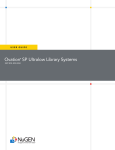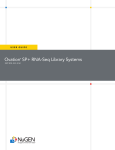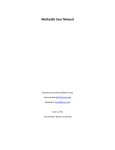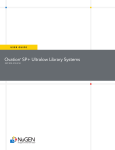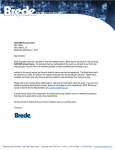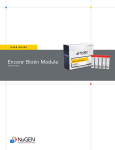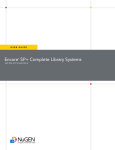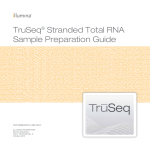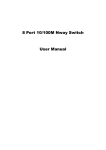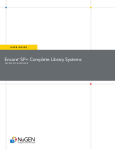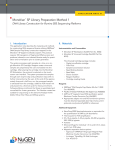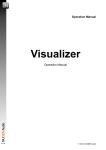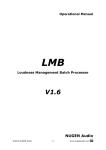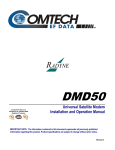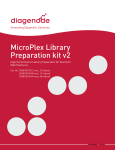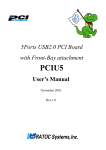Download User Guide
Transcript
USER GUIDE Encore SP Rapid Library Systems ® PART NOS. 8041 and 8042 Patents, Licensing and Trademarks ©2012–2013 NuGEN Technologies, Inc. All rights reserved. The Encore®, Ovation® and Applause® families of products and methods of their use are covered by several issued U.S. and International patents and pending applications (www.nugen.com). NuGEN, Ovation, SPIA, Ribo-SPIA, Applause, Encore, Prelude, Mondrian and Imagine More From Less are trademarks or registered trademarks of NuGEN Technologies, Inc. Other marks appearing in these materials are marks of their respective owners. Specific information on patents, trademarks and licenses related to the Mondrian™ SP Universal Cartridge, the Mondrian™ SP+ Cartridge, the Mondrian™ SP Workstation and the Mondrian™ SP+ Workstation may be found in the Mondrian SP Universal Cartridge User Guide (M01265), the Mondrian SP+ Cartridge User Guide (M01344), the Mondrian SP Workstation User Manual (Part No. M01264) and the Mondrian SP+ Workstation User Manual (M01322). The purchase of this product conveys to the buyer the limited, non-exclusive, non-transferable right (without the right to modify, reverse engineer, resell, repackage or further sublicense) under these patent applications and any patents issuing from these patent applications to use this product and methods, accompanying this user guide, for research and development purposes solely in accordance with the intended use described and the written instructions provided in this user guide. No license to make or sell products by use of this product is granted to the buyer whether expressly, by implication, by estoppels or otherwise. In particular, the purchase of this product does not include or carry any right or license to use, develop or otherwise exploit this product commercially and no rights are conveyed to the buyer to use the product or components of the product for purposes including commercial services or clinical diagnostics. For information on purchasing a license to the NuGEN patents for uses other than in conjunction with this product or to use this product for purposes other than research, please contact NuGEN Technologies, Inc., 201 Industrial Road, Suite 310, San Carlos, CA 94070. Phone 888-654-6544 or 650-590-3600; FAX 888-296-6544 or 650-590-3630. Warranty NuGEN warrants that this product meets the performance standards described in the Company’s product and technical literature for a period of six months from the date of purchase, provided that the product is handled and stored according to published instructions, and that the product is not altered or misused. If the product fails to meet these performance standards, NuGEN will replace the product free of charge or issue a credit for the purchase price. NuGEN’s liability under this warranty shall not exceed the purchase price of the product. NuGEN shall assume no liability for direct, indirect, consequential or incidental damages arising from the use, results of use or inability to use its products. NuGEN reserves the right to change, alter or modify any product to enhance its performance and design. NuGEN’s products are developed, designed and sold FOR RESEARCH USE ONLY. This product is not to be used for diagnostic or therapeutic purposes, nor is it to be administered to humans or animals. Except as expressly set forth herein, no right to modify, reverse engineer, distribute, offer to sell or sell NuGEN’s product is conveyed or implied by buyer’s purchase of this NuGEN product. The buyer agrees to use NuGEN products accompanying the product insert in accordance with the intended use and the written instructions provided. Table of Contents Contents I.Introduction.......................................................................................................... 1 A.Background........................................................................................................ 1 B. Performance Specifications................................................................................ 3 C. Library Quantification......................................................................................... 3 D. Quality Control .................................................................................................. 3 E. Storage and Stability.......................................................................................... 4 F. Material Safety Data Sheet (MSDS).................................................................... 4 II.Components......................................................................................................... 5 A. Reagents Provided............................................................................................. 5 B. Additional Equipment, Reagents and Labware................................................. 7 III. Planning the Experiment...................................................................................... 9 A. Input DNA Requirements................................................................................... 9 B. Using Encore SP Rapid Library Systems on Illumina NGS Systems................... 9 C. Library Quantification....................................................................................... 10 D. Final Library Storage........................................................................................ 10 IV.Protocol.............................................................................................................. 11 A.Overview.......................................................................................................... 11 B. Protocol Notes................................................................................................. 11 C. DNA Fragmentation......................................................................................... 11 D. Cartridge Quality Control Check..................................................................... 12 E. Protocol for the Encore SP Rapid Library Systems on Mondrian SP Cartridges.............................................................................. 15 V. Quantitative and Qualitative Assessment of the Purified Libraries.................... 22 A.Overview.......................................................................................................... 22 B. Quantification Using KAPA Biosystems Products............................................. 22 C. Gel Analysis of KAPA qPCR Product................................................................ 22 VI. Technical Support............................................................................................... 24 VII.Appendix............................................................................................................ 25 A. Preparation of Encore SP Rapid Library Systems Libraries for Cluster Generation on Illumina Systems.......................................................... 25 B. Barcode Sequences......................................................................................... 28 C. Frequently Asked Questions (FAQs)................................................................ 29 D. Update History................................................................................................. 31 I.Introduction A. Background The Encore® SP Rapid Library Systems, composed of Encore SP Rapid DR Multiplex Systems 1–8 and 9–16 (Part Nos. 8041 and 8042), are complete reagent, cartridge and protocol packages for the simple automation of DNA library preparation protocols for next generation sequencing using the Mondrian™ SP or SP+ Workstation. These systems enable library preparation from 100–400 ng of sheared, double-stranded DNA (dsDNA) and do not require any post-Mondrian PCR enrichment or purification prior to library quantitation and sequencing. The resulting libraries are suitable for a range of sequencing applications including RNA-Seq, Digital Gene Expression (DGE), genomic DNA sequencing and amplicon sequencing. As shown in Figure 1, the streamlined workflow consists of five steps: 1. Fragmentation of either genomic DNA or double-stranded cDNA to produce the assay template 2. Addition of the template and reagents to the Mondrian SP Universal Cartridge (see Figure 1A) 3. Hands-free automation of the following assay steps on the Mondrian SP or SP+ Workstation (see Figure 1B): • Sample concentration • End repair • Sample purification • Adaptor ligation (with optional sample multiplexing) • Sample purification • Final repair 4. Library quantification with KAPA Library Quantification Kit 5. Cluster formation and sequencing (see Figure 1C) 1 Encore SP Rapid Library Systems I.Introduction Figure 1. The five steps of the Encore SP Rapid Library System workflow. A) Steps 1–2: Covaris fragmentation of the dsDNA template and loading the Mondrian SP Cartridge with template and reagents. B) Step 3: assay steps automated on the Mondrian SP Cartridge. C) Steps 4–5: library quantification, cluster formation and sequencing. Mondrian™ SP Cartridge E4 Filler Fluid D4 Step 1 ≥100–400 ng fragmented DNA generated on a Covaris instrument E5 D5 Step 2 Make master mix, load in reagent ports E7 D6 D7 Sample Collection 1 2 3 1 2 3 4 5 6 7 8 6 7 8 Adaptors 4 5 Encore® SP Rapid Library Systems Single use only! P01199 v1 Sample Input 1 2 3 4 5 6 Step 3 Mondrian SP or SP+ Workstation performs the following steps in ~4 hours: 7 8 Encore SP Rapid Library System reagents Sample concentration 5´ P 3´ P End repair steps 1 and 2 Sample purification Add adaptors and ligate (optional multiplexing) Sample purification 5´ 3´ Final repair Steps 4–5 Step 4 Performed off Library quantification Mondrian SP or SP+ Workstation Step 5 Cluster formation and sequencing 2 Encore SP Rapid Library Systems Library quantification AATCGGATCGGTAGGAT … TCTCGATGCAAGTGATC … GTAGCAAAATCCTGAGA … I.Introduction The entire workflow requires no manual bead purification or gel purification steps. Starting with 100–400 ng of fragmented double-stranded DNA (dsDNA), the protocol can be completed in approximately 4 hours and yields libraries ready for quantification prior to cluster formation and either single read or paired-end sequencing. Importantly for DNA sequencing applications, samples can be input directly to the library construction workflow without the need for pre-amplification. The absence of PCR steps in the library construction workflow makes this library construction method particularly well suited to either high- or low-GC genomes, which are often susceptible to PCR artifacts. The Encore SP Rapid DR Multiplex Systems 1–8 and 9–16 each provide eight unique dedicated read barcoded adaptors to prepare libraries for multiplex sequencing using a dedicated read design strategy with a second sequencing primer. Together, these two multiplex kits enable up to 16-plex sequencing. Important: Please familiarize yourself with the instructions in the Mondrian SP Universal Cartridge User Guide (Part No. M01265) and the Mondrian SP+ Workstation User Manual (Part No. M01322) prior to beginning any work with the Encore SP Rapid Library Systems. B. Performance Specifications The Encore SP Rapid Library Systems are designed to produce DNA libraries suitable for either single read or paired-end sequencing on the Illumina Genome Analyzer IIx/ IIe (GAII), MiSeq, HiScan SQ or HiSeq NGS platforms without gel-based size selection, using 100 to 400 ng input of double-stranded DNA. The absence of PCR amplification in the workflow eliminates the risk of unequal amplification or PCR bias introduced as a result of differences in template composition. The Encore SP Rapid Library Systems generate quantified libraries ready for cluster generation on an Illumina System in about 7 hours. C. Library Quantification Libraries created using Encore Rapid Library Systems must be quantified using qPCR. These libraries cannot be accurately quantified using other means. We recommend using KAPA Library Quantification kits from KAPA Biosystems for quantification. See Section V. Quantitative and Qualitative Assessment of the Purified Libraries for details. D. Quality Control Every lot of the Encore SP Rapid Library Systems undergoes functional testing to confirm that the products meet the specifications for library generation performance. 3 Encore SP Rapid Library Systems I.Introduction We recommend the use of control samples when beginning experiments and/or using a new source of samples. For RNA-based experiments (such as RNA-Seq) we recommend the use of the MicroArray Quality Control (MAQC) reference samples A and B. For DNA-based experiments (such as WGS) we recommend the use of a control DNA sample from the HapMap project. E. Storage and Stability This product contains components with multiple storage temperatures. The Encore SP Rapid Library Systems reagents are shipped in two boxes. Box 1 is shipped on dry ice and should be stored at –20°C on an internal shelf of a freezer without a defrost cycle upon receipt. Box 2 is shipped and should be stored at room temperature. The Agencourt® RNAClean® XP Beads (clear cap) are shipped separately and should be removed from the top of the Box 2 shipping carton upon delivery and stored at 4°C. The kit has been tested to perform to specifications after as many as four freeze/thaw cycles. Kits handled and stored according to the above guidelines will perform to specifications for at least six months. F. Material Safety Data Sheet (MSDS) An MSDS for this product is available on the NuGEN website at http://www.nugen.com/nugen/index.cfm/support/user-guides/. 4 Encore SP Rapid Library Systems II.Components A. Reagents Provided Table 1. Encore SP Rapid DR Multiplex System 1–8 Components and Reagents (Part No. 8041-32) 5 Encore SP Rapid Library Systems 8041 PART NUMBER 8041 DESCRIPTION 8041 BOX 8041 VIAL CAP 8041 VIAL NUMBER S01705 End Repair Buffer Mix 1 of 2 Blue ER1 ver 6 S01706 End Repair Enzyme Mix 1 of 2 Blue ER2 ver 4 S01626 End Repair Enhancer 1 of 2 Blue ER3 S01625 End Repair Enhancer Buffer Mix 1 of 2 Blue ER4 S01662 Ligation Buffer Mix 1 of 2 Yellow L1 ver 5 S01669 S01670 S01671 S01672 S01673 S01674 S01675 S01676 DR Multiplex Ligation Adaptors 1–8 1 of 2 Yellow L2V9DR-BC1 L2V9DR-BC2 L2V9DR-BC3 L2V9DR-BC4 L2V9DR-BC5 L2V9DR-BC6 L2V9DR-BC7 L2V9DR-BC8 S01467 Ligation Enzyme Mix 1 of 2 Yellow L3 ver 4 S01703 Final Repair Buffer Mix 1 of 2 Purple FR1 ver 2 S01704 Final Repair Enzyme Mix 1 of 2 Purple FR2 ver 2 S01707 Library Dilution Buffer Mix 1 of 2 N/A LD1 S01001 Nuclease-free Water 1 of 2 Green D1 P01190 Mondrian SP Cartridges (X4) 2 of 2 N/A N/A S01561 Cartridge Filler Fluid (X4) 2 of 2 N/A N/A S01556 Sample Concentration Solution 2 of 2 N/A N/A S01698 Agencourt RNAClean XP Purification Beads Shipped separately N/A N/A S01588 Bead Binding Solution 2 of 2 N/A N/A II.Components Encore SP Rapid DR Multiplex System 1–8 Components and Reagents (Part No. 8041-32) continued 8041 PART NUMBER 8041 DESCRIPTION 8041 BOX 8041 VIAL CAP 8041 VIAL NUMBER S01589 Bead Wash Solution 2 of 2 N/A N/A S01590 Elution Buffer 2 of 2 N/A N/A P01199 Encore SP Rapid Cartridge Loading Guide (X4) 2 of 2 N/A N/A Table 2. Encore SP Rapid DR Multiplex System 9–16 Components and Reagents (Part Number 8042-32) 6 Encore SP Rapid Library Systems 8042 PART NUMBER 8042 DESCRIPTION 8042 BOX 8042 VIAL CAP 8042 VIAL NUMBER S01705 End Repair Buffer Mix 1 of 2 Blue ER1 ver 6 S01706 End Repair Enzyme Mix 1 of 2 Blue ER2 ver 4 S01626 End Repair Enhancer 1 of 2 Blue ER3 S01625 End Repair Enhancer Buffer Mix 1 of 2 Blue ER4 S01662 Ligation Buffer Mix 1 of 2 Yellow L1 ver 5 S01677 S01678 S01679 S01680 S01681 S01682 S01683 S01684 DR Multiplex Ligation Adaptors 9–16 1 of 2 Yellow L2V9DR-BC9 L2V9DR-BC10 L2V9DR-BC11 L2V9DR-BC12 L2V9DR-BC13 L2V9DR-BC14 L2V9DR-BC15 L2V9DR-BC16 S01467 Ligation Enzyme Mix 1 of 2 Yellow L3 ver 4 S01703 Final Repair Buffer Mix 1 of 2 Purple FR1 ver 2 S01704 Final Repair Enzyme Mix 1 of 2 Purple FR2 ver 2 S01707 Library Dilution Buffer Mix 1 of 2 N/A LD1 II.Components Encore SP Rapid DR Multiplex System 9–16 Components and Reagents (Part No. 8042-32) continued 8042 PART NUMBER 8042 DESCRIPTION 8042 BOX 8042 VIAL CAP 8042 VIAL NUMBER S01001 Nuclease-free Water 1 of 2 Green D1 P01190 Mondrian SP Cartridges (X4) 2 of 2 N/A N/A S01561 Cartridge Filler Fluid (X4) 2 of 2 N/A N/A S01556 Sample Concentration Solution 2 of 2 N/A N/A S01698 Agencourt RNAClean XP Purification Beads Shipped separately N/A N/A S01588 Bead Binding Solution 2 of 2 N/A N/A S01589 Bead Wash Solution 2 of 2 N/A N/A S01590 Elution Buffer 2 of 2 N/A N/A P01199 Encore SP Rapid Cartridge Loading Guide (X4) 2 of 2 N/A N/A B. Additional Equipment, Reagents and Labware Required Materials • Equipment -- Mondrian SP Workstation (NuGEN Part No. 8000) or Mondrian SP+ Workstation (NuGEN Part No. 8100) -- Nanodrop® UV-Vis Spectrophotometer or appropriate spectrophotometer and cuvettes for quantification of fragmented DNA -- Covaris™ S-series Sonication System to fragment input DNA -- Agilent 2100 Bioanalyzer (optional) for analysis of DNA fragmentation -- Materials and equipment for electrophoretic analysis of nucleic acids including 2% agarose gels, DNA ladders (1 kB and 50 bp recommended) -- Real-time PCR system capable of SYBR Green detection -- Microcentrifuge for individual 1.5 mL and 0.5 mL tubes -- 0.5–10 μL pipette, 2–20 μL pipette, 20–200 μL pipette -- Vortexer 7 Encore SP Rapid Library Systems II.Components • Reagents -- 1X TE buffer (low EDTA), pH 8.0 (Affymetrix, Cat. #75793) for input DNA samples -- KAPA Library Quantification Kit specified for Illumina and the real-time PCR system to be used -- Quant-iT™ PicoGreen® dsDNA Assay Kit for quantifying fragmented DNA • Supplies and Labware -- Nuclease-free pipette tips -- 1.5 mL and 0.5 mL RNase-free microcentrifuge tubes -- 0.2 mL individual thin-wall PCR tubes or 8 X 0.2 mL strip PCR tubes or 0.2 mL thin-wall PCR plates -- Disposable gloves -- Kimwipes -- Ice bucket -- Cleaning solutions such as DNA·OFF™ (MP Biomedicals, Cat. #QD0500) To Order: • • • • • • • 8 Encore SP Rapid Library Systems Affymetrix, www.affymetrix.com Agilent, www.agilent.com Covaris, www.covarisinc.com Invitrogen, www.invitrogen.com KAPA Biosystems, www.kapabiosystems.com MP Biomedicals, www.mpbio.com Nanodrop, www.nanodrop.com III.Planning the Experiment A. Input DNA Requirements The Encore SP Rapid Library Systems are designed to work with 100 to 400 ng of fragmented genomic DNA or ds-cDNA. DNA samples must be free of contaminating proteins, RNA, organic solvents (including phenol and ethanol) and salts. We recommend using a commercially available system for DNA/cDNA isolation. To obtain optimal library yields, we recommend that the Encore SP Rapid Library System input be determined based on both the fragment size of the sample and the method of quantification. For 200-bp fragments the recommended input is 200 ng (if measured using either NanoDrop or UV absorbance) or 100 ng (if measured using PicoGreen quantification). For 500-bp fragments the recommended input is 350 ng (if measured using either NanoDrop or UV absorbance) or 250 ng (if measured using PicoGreen quantification). Note: We recommend PicoGreen quantification of the input DNA as it provides greater library yield consistency. If using NanoDrop or UV absorbance, the A260:A280 ratio for DNA samples should be in excess of 1.8. Using DNA samples with lower ratios may result in low library yield. B. Using Encore SP Rapid Library Systems on Illumina NGS Systems The Encore SP Rapid Library Systems use a ‘Dedicated Read’ (DR) design with a second sequencing primer for multiplex sequencing. Figure 2 depicts the DR multiplex barcode strategy. Figure 2. Dedicated read multiplexing strategy used by the Encore SP Rapid Library Systems. Dedicated Read Barcode Design Illumina Standard Seq Primer Library Insert Illumina Index Seq Primer Barcode Flow cell surface The Encore SP Rapid DR Multiplex Systems 1–8 and 9–16 use the same approach to multiplexing used in the standard Illumina method. These libraries should be sequenced using the Illumina protocol for multiplex sequencing. The DR barcode sequences are found in Appendix B and must be entered into the Illumina software prior to the analysis. 9 Encore SP Rapid Library Systems III.Planning the Experiment C. Library Quantification Libraries created using Encore Rapid Library Systems must be quantified using qPCR. These libraries cannot be accurately quantified using other means. We recommend using KAPA Library Quantification kits from KAPA Biosystems for quantification. See Section V. Quantitative and Qualitative Assessment of the Purified Libraries for details. D. Final Library Storage Libraries may be stored at –20°C. 10 Encore SP Rapid Library Systems IV.Protocol A. Overview The library preparation process used in the Encore SP Rapid Library Systems is performed on the Mondrian SP or SP+ Workstation. The process includes sample concentration, DNA end repair, purification, adaptor ligation and final end repair. It takes approximately 4 hours to complete. The end product is a purified library that is ready for quantification prior to cluster generation on Illumina systems. Library quantification via qPCR takes approximately 3 hours (including qPCR, KAPA product gel and quantification calculations), so the total time to prepare purified and quantified libraries ready for sequencing is approximately 7 hours. B. Protocol Notes • The system is designed and intended for processing eight samples at a time. Do not attempt to prepare smaller volume master mixes or process fewer than eight samples using the Encore SP Rapid Library Systems. • We recommend the routine use of a positive control DNA. Especially the first time you set up a reaction, the use of a positive control DNA will allow you to establish a performance baseline. • Use the water provided with the kit (green cap, vial D1) or an alternate source of nuclease-free water. We do not recommend the use of DEPC-treated water with this protocol. • Thaw components used in each step and immediately place them on ice. • Always keep thawed reagents and reaction tubes on ice unless otherwise instructed. • After thawing and mixing buffer mixes, if any precipitate is observed, re-dissolve it completely prior to use. You may gently warm the buffer mix for 2 minutes at room temperature followed by brief vortexing. Do not warm any enzyme or primer mixes. • When placing small amounts of reagents into the reaction mix, pipet up and down several times to ensure complete transfer. • When instructed to pipet mix, gently aspirate and dispense a volume that is at least half of the total volume of the reaction mix. • Always allow the thermal cycler to reach the initial incubation temperature prior to placing the tubes or plates in the block. • Components and reagents from other NuGEN® kits should not be used with the Encore SP Rapid Library Systems. C. DNA Fragmentation We recommend using a Covaris S-series instrument to fragment DNA or ds-cDNA to the desired size prior to starting the Encore SP Rapid Library Systems protocol. 1. Dilute appropriate amount of intact DNA into 120 μL of 1X TE buffer (low EDTA), pH 8.0. 2. Transfer 120 μL to Covaris snap cap microtube. 11 Encore SP Rapid Library Systems IV.Protocol 3. Fragment to desired insert size following Covaris recommended settings. 4. Quantify fragmented samples by either UV absorbance or Quant-iT PicoGreen dsDNA assay (preferred). D. Cartridge Quality Control Check The Mondrian SP Cartridge QC protocol is a QC check that we recommend be performed prior to adding samples and reagents to the Mondrian SP Cartridge. This QC check confirms the functionality of the Mondrian SP Cartridges prior to use. The Mondrian SP Cartridge QC protocol requires inserting the Filler Fluid-containing cartridge into the deck of the Mondrian SP or SP+ Workstation. Some customers may find it easier to place the fluid-containing cartridge into the deck of the workstation and then pipet the Elution Buffer into the cartridge. Alternatively, it may be easier to pipet the Elution Buffer into the fluid-containing cartridge (while the cartridge rests on the bench top) and then insert the reagent and fluid-filled cartridge into the deck of the Workstation (moving carefully to avoid spilling the fluid or disturbing the reagent). 1. Locate the Cartridge Loading Guide that is provided with each Mondrian SP Cartridge and place the loading guide on the cartridge (Note: it is only possible to place the loading guide on the cartridge in a single orientation). 2. Optional: Carefully move the Filler Fluid-containing cartridge (and its Cartridge Loading Guide) to the deck of the Mondrian SP or SP+ Workstation and insert the cartridge into the deck. 3. Remove the Elution Buffer reagent tube (shipped and stored at room temperature) from the Encore SP Rapid Library System kit: 4. Using a 50- or 100-µL single-channel pipette set to 50 µL, load 50 µL of Elution Buffer into port E5 of the Mondrian SP Cartridge. When adding sample or reagent, lower the pipette tip to the bottom of the port. Do not press the tip into the bottom of the cartridge (if the tip contacts the bottom of the cartridge withdraw the pipette tip slightly upwards). Slowly depress the plunger (to the first stopping point) to dispense the reagent completely from the pipette tip (do not depress the plunger completely as this will introduce bubbles into the cartridge). Once all of the reagent is dispensed from the pipette tip, pull the pipette tip back out of the port and dispose of the tip. Note: Do NOT add any samples or other reagents to the cartridge at this time. Ensure that only Elution Buffer has been loaded. 5. If the cartridge is not already inserted into the Mondrian SP or SP+ Workstation deck, carefully transport the cartridge to the Mondrian SP or SP+ Workstation and insert the cartridge into the deck. 6. If not already ON, locate the workstation ON/OFF switch at the back of the workstation and turn ON. 12 Encore SP Rapid Library Systems IV.Protocol 7. Press the ‘On’ button (Figure 3) on the front of the workstation to turn the instrument on. Figure 3. The Mondrian SP or SP+ Workstation ‘On’ button, located on the front of the workstation 8. Pull the cartridge lever of the Mondrian SP or SP+ Workstation forward to the locked position and close the lid of the workstation. 9. Select ‘Run’ on the touch screen menu, choose the Mondrian SP Cartridge QC protocol from the list of protocols and then select ‘Next’ to proceed to the Protocol Information screen. 10. Select ‘Next’ to proceed to the Run Information screen. 11. Optional: Enter run details as required in the Run Information screen. 12. Select Next to proceed to the Run Confirmation screen and select ‘Start Run’. The Mondrian SP Cartridge QC protocol will take about nine minutes to complete. During this test, Elution Buffer droplets will be dispensed from the E5 port and transported around the cartridge prior to being discarded. The purpose of this test is to confirm the successful transport of droplets across all lanes of the cartridge. At the end of the protocol, the instrument will display the Run Complete screen and one of the following messages: 13 Encore SP Rapid Library Systems IV.Protocol MESSAGE MEANING NEXT STEP Mondrian™ SP cartridge passed. Continue to intended protocol. No errors detected. Droplet transport was normal. Press ‘OK’ on the Run Complete screen to return to the main menu. Proceed to section C: Loading Samples and Reagents (below) in the Mondrian SP Universal Cartridge user guide or follow the instructions (for 3rd party reagents) in the appropriate applications note. The user may remove the cartridge from the Workstation to load samples and remaining reagents on the bench top, taking care that the cartridge remains level at all times. Note: It is not necessary to add additional Elution Buffer or Filler Fluid to the cartridge prior to loading reagents and samples. Mondrian™ SP cartridge failed. Remove cartridge from instrument deck and set aside prior to contacting NuGEN Technical Support. A problem was detected with droplet transport within the cartridge. Press ‘OK’ on the Run Complete screen to return to the main menu. Remove the cartridge from the deck and set it aside (do not discard) and contact NuGEN Technical Support for further instructions. Users who proceed with SP protocols and/or who load additional SP reagents and samples onto failed cartridges are doing so at their own risk and will not be compensated for loss of reagents, samples or cartridges by NuGEN Technologies, Inc. Mondrian™ SP cartridge status is undetermined. Please consult Mondrian™ SP Universal Cartridge User Guide or appropriate NuGEN® SP Library Systems User Guide for further instructions. The results are inconclusive and must be repeated one more time prior to making a determination on the quality of the cartridge. Repeat the Mondrian SP Cartridge QC protocol one more time. • Do not add any additional Filler Fluid or Elution Buffer to the cartridge. • Press OK on the Run Complete screen to return to the main menu. • Proceed to re-run the Mondrian SP Cartridge QC protocol starting from Step 10 in the protocol above. If the message after the second Mondrian SP Cartridge QC protocol is: • ‘Mondrian SP cartridge passed,’ then proceed as outlined in Next Step for passing cartridges (above). • ‘Mondrian SP Cartridge failed’ or ‘Mondrian SP cartridge status is undetermined,’ do not use the cartridge and contact NuGEN Technical Support. 14 Encore SP Rapid Library Systems IV.Protocol E. Protocol for the Encore SP Rapid Library Systems on Mondrian SP Cartridges 1. Sample Solution Preparation Prepare sample solution for loading onto the cartridge (this is done on a per sample basis and not as a master mix) according to the volumes shown in Table 3. You must prepare and process no fewer than eight samples on each cartridge. Table 3. Sample Solution Preparation COMPONENT VOLUME 100 to 400 ng sheared ds DNA in water or low EDTA TE 21.4 µL Agencourt RNAClean XP beads 3.6 µL Sample Concentration Solution 25 µL Total volume 50 µL Ensure Agencourt RNAClean XP beads are at room temperature and completely resuspended prior to use. Mix each sample solution well and incubate at room temperature (approximately 23°C) for 10 minutes. The above recipe is meant for one sample. Prepare sample solution for each sample to be processed. 2. Encore SP Rapid Library Systems Reagent Master Mix Preparation Prepare End Repair Master Mix 1. Thaw End Repair Buffer Mix (ER1 ver 6) at room temperature, vortex to mix well and spin down briefly. Keep End Repair Enzyme Mix (ER2 ver 4) on ice. 2. Prepare master mix in a 0.5 mL microcentrifuge tube or 0.2 mL PCR tube according to the volumes shown in Table 4. Label the tube D6. 15 Encore SP Rapid Library Systems IV.Protocol Table 4. End Repair Master Mix Mix by pipetting and spin down the master mix briefly. Place on ice. Use immediately. Component Vial Cap Volume End Repair Buffer Mix (ER1 ver 6) Blue 7.0 µL End Repair Enzyme Mix (ER2 ver 4) Blue 3.0 µL Total volume 10.0 µL Prepare End Repair Enhancer Master Mix 1. Thaw End Repair Enhancer Buffer Mix (ER4) at room temperature, vortex to mix well and spin down briefly. Keep End Repair Enhancer (ER3) on ice. 2. Prepare master mix in a 0.5 mL microcentrifuge tube or 0.2 mL PCR tube according to the volumes shown in Table 5. Label the tube D7. Table 5. End Repair Enhancer Master Mix Mix by pipetting and spin down the master mix briefly. Place on ice. Use immediately. Component Vial Cap Volume End Repair Enhancer Buffer Mix (ER4) Blue 7.0 µL End Repair Enhancer (ER3) Blue 3.0 µL Total volume 10.0 µL Prepare Ligation Master Mix 1. Thaw Ligation Buffer Mix (L1 ver 5) at room temperature, vortex to mix well and spin down briefly. Keep Ligation Enzyme Mix (L3 ver 4) on ice. 2. Prepare master mix in a 0.5 mL microcentrifuge tube or 0.2 mL PCR tube according to the volumes shown in Table 6. Label the tube D5. Table 6. Ligation Master Mix Mix by pipetting and spin down the master mix briefly. Place on ice. Use immediately. Component Vial Cap Volume Ligation Buffer Mix (L1 ver 5) Yellow 7.0 µL Ligation Enzyme Mix (L3 ver 4) Yellow 3.0 µL Total volume 16 Encore SP Rapid Library Systems 10.0 µL IV.Protocol Prepare Final Repair Master Mix 1. Thaw Final Repair Buffer Mix (FR1 ver 2) at room temperature, vortex to mix well and spin down briefly. Keep Final Repair Enzyme Mix (FR2 ver 2) on ice. 2. Prepare master mix in a 0.5 mL microcentrifuge tube or 0.2 mL PCR tube according to the volumes shown in Table 7. Label the tube D4. Table 7. Final Repair Master Mix Mix by pipetting and spin down the master mix briefly. Place on ice. Use immediately. Component Vial Cap Volume Final Repair Buffer Mix (FR1 ver 2) Purple 8.0 µL Final Repair Enzyme Mix (FR2 ver 2) Purple 2.0 µL Total volume 10.0 µL Prepare Adaptors 1. Thaw ligation adaptors at room temperature, vortex well to mix and spin down briefly. Use the desired barcode adaptors L2V9DR-BC1–16 (yellow vial cap). 2. The adaptors will be loaded onto the cartridge as indicated below (Step 8 of the Mondrian SP Cartridge Loading Instructions). 3. Mondrian SP Cartridge Loading Instructions Important: For detailed instructions on how to prepare the Mondrian SP Cartridge for reagent and sample loading, refer to Mondrian SP Universal Cartridge User Guide (M01265). 17 Encore SP Rapid Library Systems IV.Protocol Figure 4. Mondrian SP Cartridge loading guide for the Encore SP Rapid Library System protocol. E4 Filler Fluid D4 E5 D5 E7 D6 D7 Sample Collection 1 2 3 4 5 6 7 8 6 7 8 Adaptors 1 2 3 4 5 Encore SP Rapid Library Systems ® Single use only! P01199 v1 Sample Input 1 2 3 4 5 6 7 8 Loading Reagents and Samples in the Mondrian SP Cartridge Using Figure 4 as a guide, follow the instructions below to load reagents into their appropriate cartridge ports. • Use a 10 µL pipette to add all reagent master mixes and the adaptors. Important: It is critical that a 10 or 20 μL pipette be used for adding any volumes of ≤10 μL. Do not use 2 μL pipettes to add reagents to the cartridge as they will not generate sufficient force to expel the reagents from the pipette tip into the Filler Fluid-containing cartridge. • Use a 100 or 200 µL pipette for adding the samples, Bead Binding Solution, Elution Buffer and Bead Wash Solution. • Load the ports in a steady manner to avoid overflow of the Filler Fluid. • When adding sample or reagent, lower the pipette tip to the bottom of the port. Do not press the tip into the bottom of the cartridge. If the tip contacts 18 Encore SP Rapid Library Systems IV.Protocol the bottom of the cartridge, withdraw the pipette tip slightly upwards. Slowly depress the plunger to the first stopping point to dispense the reagent completely from the pipette tip. As you raise the pipette tip from the port, you should complete a gentle blow-out by fully depressing the pipette plunger just E5 all the E7 prior to exiting reagent is dispensed. Filler the Filler Fluid toE4ensure Fluid Using a desktop lamp to illuminate your work area may facilitate sample and D4 D5 D6 D7 reagent loading. We recommend loading the reagents and samples with the cartridge on the deck of the Mondrian SP or SP+ Workstation. Sample Collection 1. Load 1.5 µL of each adaptor mix into ports A1–A8 using a 10 µL pipette. Use L2 ver 10 for 1all samples. 2 3 Adaptor 4 5ports 6 A1 through 7 8 A8 are highlighted with yellow rims. Adaptors 1 2 3 4 5 6 7 8 Encore SP Rapid Library Systems Single use only! Note: If the adaptor droplet appears to be floating above the surface of the bottom plate of the cartridge, use a clean pipette tip to gently push Filler Fluid the droplet down to the surface. ® E4 P01199 v1 2. Load 8 µL Final Repair Master Sample Mix into D4. Port D4 is highlighted with a Input white rim circled with a dark line. Filler E4 D4 E5 E5 D5 D6 D7 E7 Fluid 1 2 3 4 5 6 7 8 3. Load 8 µL Ligation Master Mix into D5. Port D5 is highlighted with an D4Sample D5 Collection D6 D7 E4 E5 E7 orange rim. Filler Fluid 1 2 3 4 5 4. Load 8 µL End Repair Master Mix into D6. Port D6 is highlighted with a D5 Collection D4Sample D6 D7 E4 E5 E7 Filler green rim. Adaptors Fluid 1 2 3 4 5 6 6 7 7 8 1Sample 2 Collection 3 4 5 6 7 5. Load 8 µL End Repair Enhancer Master Mix into D7. Port D7 isD4 highD5 D6 D7 ® lighted with a blue rim. Encore SP Rapid Library System Adaptors 6. 2 3 4 5 6 7 2 3 4 5 6 7 8 1 2 3 4 5 8 Single use only! 1Sample 2 Collection 3 4 5 6 7 8 Load 50 µL Bead Binding Solution in E4. Port E4 is not highlighted in E5 E7 E4 Filler ® any way. Fluid Encore SP Rapid Library Systems Adaptors 1 Single use only! Sample Load 50 µL Elution Buffer into E5. Port E5 is highlighted with a3grey rim. 1 2 4 5 D4 6 D5Input 7 D6E7 8 D7 E4 E5 Filler Fluid Encore® SP Rapid Library Systems Adaptors P01199 v1 7. 1 P01199 v1 P01199 v1 P01199 v1 useSample only! Collection Note: This step is required only if Elution1Buffer was notSingle Sample 2 3 4 5 D4 6 D5Input 7 D6 8 D7 added during the Cartridge QC Protocol. Do not add 1 2Library 3 Systems 4 5 6 Encore® SP Rapid additional Elution Buffer if this reagent was already added to 1 2 3 4 5 6 only! Collection Sample the cartridge during the Cartridge QC Protocol. Single use Sample Input 1 1 2 2 3 Adaptors 4 3 4 1Sample 2 Input3 5 5 4 6 6 5 7 8 8 8 7 Encore SP Rapid Library Systems Adaptors ® 1 2 1 3 4 2 3 5 Single 6 use 7 only! 8 4 5 6 7 Encore SP Rapid Library Systems Single use only! Sample Input 199 v1 Encore SP Rapid Library Systems 6 7 7 7 7 ® 19 6 8 IV.Protocol E4 Filler Fluid D4 E5 D5 E7 D6 D7 Sample Collection 1 2 3 4 5 6 7 8 8. Load 50 µL Bead Wash Solution into Adaptors E7. Port E7 is highlightedE4withE5a Filler black rim. Fluid 1 2 3 4 5 6 7 E7 8 Encore SP Rapid Library Systems D4 D5 D6 D7 9. Load 50 µL of sample mix into S1–S8 (ensure that the 10-minute incubation step Single use only! described above is performed prior to loading onto the cartridge.) Sample input Sample Collection ports are highlighted with red rims. ® 1 2 P01199 v1 Sample Input 1 2 3 4 5 6 1 3 5 6 7 8 6 7 8 8Adaptors 7 2 4 3 4 5 10. If the cartridge is not already inserted into the Mondrian SP+ Workstation deck, ® Encore SP Rapid Library Systems insert the cartridge into the deck and pull the locking lever forward to engage the Single use only! cartridge with the control electronics and close the lid. Mondrian SP Workstation Initialization Instructions Sample Input P01199 v1 1. If not already ON, locate the workstation ON/OFF switch at the back of the workstation and turn ON. 1 2 2. Press the ‘On’ button on the front of the workstation. 3 4 5 6 7 8 3. Select ‘Run’ on the touch screen menu, select ‘Encore SP Rapid’ from the list of available protocols and follow the instructions on the screen to begin the run. Library Collection from the Mondrian SP Cartridge Note: A short instructional video on ‘Mondrian Sample Collection’ is available on the Mondrian Support page at www.nugen.com/mondriansupport. 1. Place 8 low-binding 0.2 mL or 0.5 mL microcentrifuge tubes in a rack. Add 11 µL of Library Dilution Buffer (LD1) to each tube. 2. Use a 100 or 200 µL pipette set to 20 µL. Depress the plunger on the pipette and insert the tip all the way to the bottom of the sample collection port, perpendicular to the cartridge to make a seal between the cartridge and the pipet tip. 3. Maintaining the seal formed between the pipette tip and the bottom of the cartridge, release the plunger. Immediately lift the pipette slightly off the bottom of the cartridge to release the seal, rapidly drawing Filler Fluid and the sample droplet into the pipette tip. 4. Examine the pipette tip to ensure that the appropriately sized droplet is suspended in the Filler Fluid. 20 Encore SP Rapid Library Systems IV.Protocol 5. Dispense the collected fluid including the small sample droplet directly into the 11 µL of Library Dilution Buffer in the collection tube. Pipette up and down a few times in the aqueous phase to ensure that all the sample transfers into the buffer. 6. Discard the tip and repeat steps 2–5 to ensure complete collection of the entire sample. This is important because occasionally a portion of the sample droplet is left behind in the sample collection port. 7. Continue to the next sample collection port and repeat this process until all eight libraries have been collected and placed in separate tubes. 8. Remove the cartridge from the workstation and dispose of as appropriate in laboratory waste. 9. Cap the library droplet-containing PCR tubes and vortex briefly to mix. Spin down briefly to bring the aqueous phase to the bottom of the tube. The Filler Fluid oil should remain as a separate layer on top of the aqueous phase. 10. Use a pipette to remove most of the Filler Fluid floating on top of the aqueous phase. This will aid the aqueous phase collection. 11. Use a fresh tip to transfer the aqueous phase (11 µL) from beneath the remaining Filler Fluid and into a fresh tube. 12. The aqueous phase contains the purified library. Store the library at –20°C or proceed immediately to library quantitation. 21 Encore SP Rapid Library Systems V. Quantitative and Qualitative Assessment of the Purified Libraries A. Overview This section details how to prepare Encore SP Rapid libraries for quantification and qualification prior to cluster generation and sequencing. Important: Libraries created using Encore Rapid Library Systems must be quantified using qPCR. These libraries cannot be accurately quantified using other means. We recommend using KAPA Library Quantification kits from KAPA Biosystems for quantification. B. Quantification Using KAPA Biosystems Products Use the KAPA Library Quantification kit specific for the Illumina NGS platform and your available qPCR instrument. Follow the instructions described by KAPA BioSystems in the Technical Data Sheet for the KAPA Library Quantification kit you are using. We recommend dilutions be performed with a volume of purified library not to exceed 1.0 μL. Problems may arise if too much sample is used when yields are low. Note: For the library qPCR reactions, we recommend loading at least duplicates of a 1:1,000 and a 1:10,000 dilution on the same plate as the KAPA Biosystems concentration standards (run in triplicate). See Appendix A for recommendations on the final pMolarity of the hybridization solution. C. Gel Analysis of KAPA qPCR Product Gel analysis of the library KAPA qPCR product is important for qualitative and quantitative analysis of the final libraries. Use the gel to determine the average size of the library as this value is required for calculation of the concentration of the libraries. Also, use the gel image to determine if adaptor dimers are present. Adaptor dimers may reduce the number of useful sequence reads. On the same 2% agarose gel, run the following lanes: 1. 5 μL of KAPA product from one well of the 1:1,000 dilution and one well of the 1:10,000 dilution for the sample library 2. 5 μL of one KAPA concentration standard 3. 10 μL (10 ng/ μL) of 1 Kb Plus and/or 50 bp ladder See Figure 5 for an example of KAPA qPCR products (generated with the Encore SP Rapid Library System) run on a 2% agarose gel. 22 Encore SP Rapid Library Systems V. Quantitative and Qualitative Assessment of the Purified Libraries Figure 5. 2% agarose gel analysis of Encore SP Rapid Library System libraries after KAPA qPCR analysis. Lane 1 is the 1 Kb Plus ladder. For size reference, the position of migration of the 1 Kb and 500 bp fragments in the 1 Kb ladder are noted with arrows. Lanes 2 through 5 are KAPA products from libraries made from increasing amounts (250 to 400 ng) of fragmented human male DNA (average size of fragment was 500 bp). 23 Encore SP Rapid Library Systems VI.Technical Support For help with any of our products, please contact NuGEN Technical Support at 650.590.3674 (direct) or 888.654.6544, option 2 (toll-free, US only). You may also send faxes to 888.296.6544 (toll-free) or email [email protected]. In Europe contact NuGEN at +31(0)135780215 (Phone) or +31(0)135780216 (Fax) or email [email protected]. In all other locations, contact your NuGEN distributor for technical support. 24 Encore SP Rapid Library Systems VII.Appendix A. Preparation of Encore SP Rapid Library Systems Libraries for Cluster Generation on Illumina Systems Guidance for preparation of Encore SP Rapid Library Systems libraries for cluster generation is provided below based upon the final library concentration. Using reduced volume, modified recipes may enable you to save an aliquot of the library for later studies. Follow the standard protocol for creation of library denaturation mix if you would like to use the entire aliquot of Encore SP Rapid Library Systems library in the sequencing reaction. We recommend following the half-volume protocol for the library denaturation mix if you would prefer to retain half the Encore SP Rapid Library Systems library aliquot for later use. If your final library concentration is between 1.11 and 1.95 nM, we recommend following the instructions below under the header ‘For Library Concentrations Lower than 2 nM.’ For Library Concentrations of 2 nM or Greater 1. Dilute libraries to a concentration 2 nM using Library Dilution Buffer Mix (LD1). 2. Mix the NaOH and the 2 nM Encore SP Rapid Library Systems library together in a microcentrifuge tube according to the volumes shown in Table 8. Table 8. Library Denaturation Mix for 2 nM libraries REAGENT Illumina Standard Protocol Half-Volume Protocol 0.1N NaOH 10 µL 5 µL 2 nM Encore SP Rapid Library Systems Library 10 µL 5 µL Initial volume of Library Denaturation Mix for 2 nM libraries 20 µL 10 µL 3. Incubate the tube at room temperature for 5 minutes. 4. Add pre-chilled HT1 reagent (from the Illumina Sequencing Reagent kit) to the microcentrifuge tube as indicated in Table 9. 25 Encore SP Rapid Library Systems VII.Appendix Table 9. Final Library Denaturation Mix for 2 nM libraries Illumina Standard Protocol Half-Volume Protocol Volume of Library Denaturation Mix already in tube 20 µL 10 µL Pre-chilled HT1 980 µL 490 µL 1000 µL 500 µL REAGENT Final volume of library denaturation mix The final concentrations of NaOH and library in the library denaturation mix are the same regardless of which volume protocol is used, as indicated in Table 10. Table 10.Final NaOH and DNA concentrations in the Library Denaturation Mix for 2 nM libraries Illumina Standard Protocol Half-Volume Protocol NaOH 1.0 mM 1.0 mM Encore SP Rapid Library Systems library 20 pM 20 pM REAGENT For Library Concentrations Lower than 2 nM If the final concentration of the Encore SP Rapid Library Systems library is lower than 2 nM (between 1.11 and 1.95 nM), we recommend using a higher concentration of NaOH (0.5N instead of 0.1N) in the library denaturation mix and adding distilled water to make up the difference in volume. 5. Calculate the volume of library required using the following formula: Library volume (µL) = 10 ÷ library concentration (nM) For example, if the final Encore SP Rapid Library System library concentration is 1.5 nM, the required volume is 10 ÷ 1.5 nM = 6.67 µL. 6. Aliquot the calculated volume of Encore SP Rapid Library System library into a microcentrifuge tube and add 0.5N NaOH and distilled water as required to generate 10 µL of Library Denaturation Mix, as shown in Table 11. 26 Encore SP Rapid Library Systems VII.Appendix Table 11.Library Denaturation Mix for <2 nM libraries REAGENT <2 nM LIBRARY PROTOCOL 0.5N NaOH 1.0 µL 1.11 to 1.95 nM Encore SP Rapid Library Systems library dH2O Volume (µL) = 10 ÷ library concentration (nM) To 10 µL final volume Initial volume of Library Denaturation Mix for <2 nM libraries 10 µL 7. Incubate the tube at room temperature for 5 minutes. 8. Add pre-chilled HT1 reagent (from the Illumina Sequencing Reagent kit) to the microcentrifuge tube as indicated in Table 12. Table 12.Final Library Denaturation Mix for <2 nM libraries REAGENT <2 nM LIBRARY PROTOCOL Volume of Library Denaturation Mix already in tube 10 µL Pre-chilled HT1 490 µL Final volume of library denaturation mix for <2 nM libraries 500 µL The final concentrations of NaOH and library in the library denaturation mix are as indicated in Table 13. Table 13.Final NaOH and library concentrations in the Library Denaturation Mix for <2 nM libraries REAGENT 27 Encore SP Rapid Library Systems <2 nM LIBRARY PROTOCOL NaOH 1.0 mM Encore SP Rapid Library Systems library 20 pM VII.Appendix B. Barcode Sequences Table 14.Barcode sequences for dedicated read (DR) adaptors 28 Encore SP Rapid Library Systems LIGATION ADAPTOR MIX BARCODE SEQUENCE L2V9DR-BC1 AAGGGA L2V9DR-BC2 CCTTCA L2V9DR-BC3 GGACCC L2V9DR-BC4 TTCAGC L2V9DR-BC5 AAGACG L2V9DR-BC6 CCTCGG L2V9DR-BC7 GGATGT L2V9DR-BC8 TTCGCT L2V9DR-BC9 ACACGA L2V9DR-BC10 CACACA L2V9DR-BC11 GTGTTA L2V9DR-BC12 TGTGAA L2V9DR-BC13 ACAAAC L2V9DR-BC14 CACCTC L2V9DR-BC15 GTGGCC L2V9DR-BC16 TGTTGC VII.Appendix C. Frequently Asked Questions (FAQs) Q1. What kind of sequencing primers can I use with your library? The Encore SP Rapid Library Systems are designed for use with the standard Illumina sequencing primers for both single end and paired-end sequencing applications. Q2. Can the Encore SP Rapid Library Systems be used with paired-end sequencing? Yes, they can be used for both single end and paired-end sequencing. Special consideration should be given to the expected insert size in the paired-end assay. Q3. How much material should I load for cluster generation? Please follow manufacturer’s recommendations and see Appendix A ‘Preparation of Encore SP Rapid Library Systems Libraries for Cluster Generation on the Illumina System.’ Q4. Do the Encore SP Rapid Library Systems work with the Illumina Cluster Station (predecessor of the cBot instrument)? Yes, the Encore SP Rapid Library Systems are also compatible with the Illumina Cluster Station. Q5. I don’t have access to a Covaris instrument. Can I use alternative fragmentation methods? We have evaluated only Covaris-fragmented DNA during the development of the Encore SP Rapid Library Systems. Other mechanical means of fragmentation, such as nebulization, may be suitable as well. Q6. How does your protocol improve the efficiency of ligation and avoid adaptor dimer formation? The Encore SP Rapid Library Systems use optimized chemistries to increase the efficiency of blunt-end adaptor ligation and minimize the amount of adaptor dimer in the library. Q7. Does NuGEN provide reagents for performing the fragmentation step of the protocol? We suggest using the Covaris instrument, as indicated in the “materials” section of this user guide. NuGEN does not provide the reagents used in the fragmentation steps. 29 Encore SP Rapid Library Systems VII.Appendix Q8. Are the libraries from the Encore SP Rapid Library Systems compatible with downstream target capture methods like Agilent’s SureSelect or Nimblegen’s SeqCap EZ? No, the libraries from the Encore SP Rapid Library Systems do not yield enough library material to be compatible with downstream target capture methods such as Agilent’s SureSelect and Nimblegen’s SeqCap EZ kits. These protocols usually require a minimum of 500 ng library input. Customers who wish to perform target selection on their samples should use the Ovation SP Ultralow Library Systems (Part Nos. 8033 and 8034) together with the Encore Target Capture Module (Part No. 0332) to prepare samples for target selection with the Agilent and Nimblegen products. Q9. How can gel purification be eliminated from the workflow and still prevent adaptor dimer formation? The Encore SP Rapid Library Systems workflow uses bead-based purification and efficient primer design, thus eliminating the need for gel-based purification. Q10.Can I use an Agilent 2100 Bioanalyzer or a Thermo Scientific NanoDrop Spectrophotometer to determine the final concentration of an Encore SP Rapid Library Systems library and use this measurement to calculate how much library I need for cluster generation? No. We do not recommend using the Agilent 2100 Bioanalyzer or the Thermo Scientific NanoDrop Spectrophotometer to quantify the Encore SP Rapid Library Systems libraries. You must quantitate these libraries using qPCR. We recommend the KAPA Biosystem Library Quantification kits. Failure to quantitate the Encore SP Rapid Library Systems libraries by qPCR will result in inaccurate concentration readings, which in turn will lead to low cluster density and poor quality sequencing results. Q11.Can the Encore SP Rapid Library Systems kits be used on the Mondrian SP+ Workstation? Yes. The Encore SP Rapid Library Systems kits can be used with both the Mondrian SP and SP+ Workstation. When using the Mondrian SP+ Workstation, select the correct Encore SP Rapid protocol. 30 Encore SP Rapid Library Systems VII.Appendix D. Update History This document, the Encore SP Rapid Library Systems user guide (M01295 v5) is an update to address the following topics. Description Section Page(s) Removed references to integration with Ovation RNA-Seq System V2 and Ovation RNA-Seq FFPE System (Part Nos. 7102 and 7150) I.A., VII.C. 3, 29 Updated Table 3 IV.E. 15 Updated Mondrian SP Cartridge Loading Instructions IV.E. 18–19 Changed loading volume for D ports IV.E 19 Updated Library Collection from Mondrian SP Cartridge section IV.E. 20–21 NuGEN Technologies, Inc. Headquarters USA Europe 201 Industrial Road, Suite 310 San Carlos, CA 94070 USA Toll Free Tel: 888.654.6544 Toll Free Fax: 888.296.6544 [email protected] [email protected] P.O. Box 109 9350 AC Leek The Netherlands Tel: +31-13-5780215 Fax: +31-13-5780216 [email protected] For our international distributors contact information, visit our website www.nugen.com ©2012–2013 NuGEN Technologies, Inc. All rights reserved. The Encore®, Ovation® and Applause® families of products and methods of their use are covered by several issued U.S. and International patents and pending applications (www.nugen.com). NuGEN, Ovation, SPIA, RiboSPIA, Applause, Encore, Prelude, Mondrian and Imagine More From Less are trademarks or registered trademarks of NuGEN Technologies, Inc. Other marks appearing in these materials are marks of their respective owners. M01295 v5 For research use only.


































